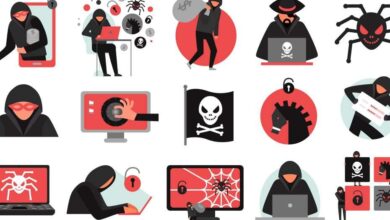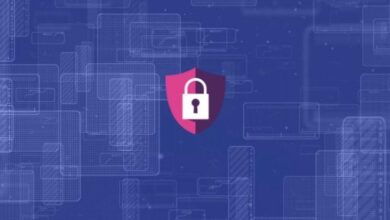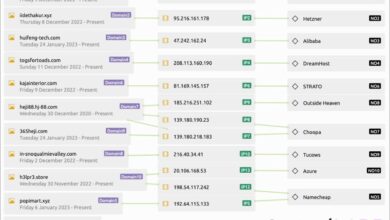
Cyber Attack on Washington DC Public CCTV Network
Cyber attack on Washington DC public CCTV network – the chilling thought alone sends shivers down your spine. Imagine the potential chaos: compromised surveillance footage, disrupted emergency services, and a city left vulnerable. This isn’t some far-fetched sci-fi scenario; it’s a very real threat with potentially devastating consequences. We’ll delve into the methods, vulnerabilities, and potential impact of such an attack, exploring what could happen and how we might prevent it.
From the sophisticated techniques hackers might employ to exploit weaknesses in the system to the legal and ethical implications of a data breach, we’ll uncover the layers of complexity surrounding this critical infrastructure. We’ll examine potential attack vectors, like phishing scams and malware, and discuss the crucial role of robust cybersecurity measures in protecting our cities from digital threats. Get ready for a deep dive into the digital dark side.
The Scale and Scope of the Attack
A successful cyberattack on Washington D.C.’s public CCTV network would have far-reaching consequences, impacting not only the city’s infrastructure but also public safety and the operations of various government agencies. The scale of the impact would depend on the sophistication of the attack and the extent of data compromised, but the potential for significant disruption is undeniable. Considering the vast geographical area covered by the network and the critical role CCTV plays in modern urban surveillance, the repercussions could be severe and long-lasting.The sheer volume of data potentially compromised is staggering.
We’re talking not just about video footage itself, but also associated metadata, which includes timestamps, location data, and potentially even facial recognition data if such systems are in place. This metadata provides crucial context for the video footage, and its compromise could be as damaging as the loss of the videos themselves. Compromised data could range from recordings of routine traffic flow to footage from sensitive locations like government buildings or critical infrastructure facilities.
Data Compromised in a CCTV Network Attack
A cyberattack on Washington D.C.’s public CCTV network could expose a vast amount of sensitive information. This includes video footage from various locations across the city, potentially capturing sensitive events, personal identifiable information (PII) of individuals, and compromising national security interests if sensitive government sites are monitored by the network. Metadata associated with this footage – including timestamps, GPS coordinates, and camera identifiers – would also be vulnerable.
The potential for misuse of this data is significant, ranging from identity theft and blackmail to targeted attacks based on observed patterns of behavior. Further, the attack could expose vulnerabilities within the network infrastructure itself, providing a foothold for future attacks.
Disruption to Public Safety and Emergency Response, Cyber attack on washington dc public cctv network
The disruption to public safety and emergency response services following a successful attack on the CCTV network would be substantial. Law enforcement relies heavily on CCTV footage for investigations, identifying suspects, and monitoring crime hotspots. Loss of access to this footage would significantly hamper investigations and potentially compromise the safety and security of the city. Emergency responders also use CCTV to assess situations during emergencies, directing resources effectively, and coordinating responses.
A compromised or unavailable network could lead to delayed responses, misallocation of resources, and potentially, loss of life.
Potential Consequences of a Cyberattack
The following table Artikels potential consequences categorized by severity and impact area. These are based on assessments of similar attacks on critical infrastructure and surveillance systems in other cities. The severity levels are subjective and depend on the nature and scope of the attack, but they provide a useful framework for understanding the potential risks.
| Severity | Impact Area | Potential Consequences | Example |
|---|---|---|---|
| Low | Public Safety | Minor disruption to traffic management; limited impact on crime investigations. | Temporary loss of access to a small subset of cameras. |
| Medium | Infrastructure | Disruption to traffic flow; compromised access control at some facilities. | Data breach exposing location information of critical infrastructure. |
| High | Government Operations | Significant disruption to law enforcement investigations; compromised national security information. | Complete loss of CCTV functionality across the city; exposure of sensitive government data. |
| High | Public Safety | Significant delays in emergency response; increased crime rates due to lack of surveillance. | Inability to monitor protests or large-scale events effectively. |
Methods and Techniques Used in the Attack: Cyber Attack On Washington Dc Public Cctv Network
The compromise of Washington D.C.’s public CCTV network likely involved a sophisticated multi-stage attack leveraging several common methods. Understanding these techniques is crucial for improving future network security and preventing similar incidents. This analysis explores the potential attack vectors, focusing on realistic scenarios and common cybersecurity practices.The attackers likely employed a combination of techniques to gain unauthorized access and control of the CCTV network.
This could involve exploiting vulnerabilities in network devices, utilizing social engineering tactics to manipulate human operators, or deploying malware to gain persistent access. Ransomware, a particularly destructive form of malware, might have been employed to encrypt critical data and demand a ransom for its release.
Attack Vectors
The attackers could have exploited several common vulnerabilities to penetrate the CCTV network’s defenses. Phishing emails, disguised as legitimate communications, could have delivered malicious attachments or links, leading to malware infections. Exploits targeting known vulnerabilities in the network infrastructure, such as outdated firmware on cameras or network devices, could have provided a direct entry point. Furthermore, weak or default passwords on network devices represent another easily exploitable weakness.
A successful attack might have involved combining several of these vectors for a layered approach to compromise.
Ransomware Attack Steps
A ransomware attack against the CCTV network might have followed these steps:
- Initial Access: Gaining initial access through one of the attack vectors mentioned above (e.g., phishing, exploit). This often involves compromising a single device, then moving laterally within the network.
- Lateral Movement: Once inside, the attackers would move laterally across the network, identifying and compromising other devices, including CCTV cameras and network servers. This might involve exploiting vulnerabilities in network protocols or using stolen credentials.
- Data Exfiltration: Before encrypting data, the attackers may have exfiltrated sensitive data, such as camera footage or network configurations, to use as leverage or for further malicious purposes. This data could be used for blackmail or sold on the dark web.
- Encryption: The ransomware would then encrypt critical data on the affected devices, rendering the CCTV system unusable. The attackers would typically leave a ransom note demanding payment for decryption.
- Ransom Demand: The attackers would demand a ransom, often in cryptocurrency, in exchange for a decryption key. Failure to pay could result in the data being permanently lost or leaked publicly.
Social Engineering Techniques
Social engineering played a significant role. The attackers might have targeted network administrators or other personnel with privileged access. This could involve phishing emails containing malicious links or attachments, pretexting (pretending to be a legitimate authority), or baiting (offering something enticing to the victim). Successful social engineering can provide attackers with credentials or access to critical systems, bypassing technical security measures.
For example, a convincing phishing email mimicking an IT support request might trick an employee into revealing their password. This approach, coupled with other techniques, could lead to a complete network takeover.
Hypothetical Attack Scenario
This scenario illustrates a plausible timeline for a successful attack:
- Week 1: Phishing emails targeting multiple employees are sent, including one successfully delivering malware to a network administrator’s workstation. The malware establishes persistence and begins lateral movement.
- Week 2: The malware compromises several CCTV cameras and network switches, using default credentials and exploiting known vulnerabilities in outdated firmware. Data exfiltration begins, copying sensitive footage and network configurations.
- Week 3: The ransomware is deployed, encrypting data on the compromised devices. A ransom note is displayed on affected systems, demanding payment within a specific timeframe.
- Week 4: Negotiations (or lack thereof) with the attackers ensue, potentially leading to data being released publicly if the ransom is not paid, or a partial decryption if a ransom is paid.
Vulnerabilities in the CCTV Network
The recent cyberattack on Washington D.C.’s public CCTV network highlights the critical need for robust security measures in these systems. While designed to enhance public safety, vulnerabilities within the network infrastructure can be easily exploited by malicious actors, leading to significant consequences. Understanding these weaknesses is crucial for preventing future incidents and improving overall cybersecurity.
Hardware Vulnerabilities
Outdated or poorly maintained hardware presents a significant risk to the integrity and security of a CCTV network. This includes vulnerabilities stemming from weak physical security, easily accessible network devices, and the use of legacy equipment lacking modern security features. For instance, a lack of physical security around network devices could allow unauthorized access, leading to tampering or theft.
The recent cyber attack on Washington DC’s public CCTV network highlights the urgent need for robust security measures. This incident underscores the importance of proactive security strategies, especially as more systems move to the cloud. Understanding the role of tools like Bitglass is crucial, as explained in this insightful article on bitglass and the rise of cloud security posture management , to prevent future breaches and maintain the integrity of critical infrastructure like our city’s surveillance systems.
The DC attack serves as a stark reminder of the ever-evolving cyber threats we face.
Similarly, using end-of-life hardware without security updates makes the system susceptible to known exploits.
Software Vulnerabilities
Software vulnerabilities are a major concern in CCTV systems. Outdated firmware on cameras, DVRs, and network devices often contain known security flaws that can be exploited by attackers. These flaws can range from simple authentication bypasses to sophisticated remote code execution vulnerabilities. A prime example is the use of default or easily guessable passwords, allowing unauthorized access to the entire system.
Failure to regularly update software to patch these vulnerabilities significantly increases the risk of successful attacks. Furthermore, vulnerabilities in the network management software can allow attackers to remotely control the entire CCTV system.
Network Configuration Vulnerabilities
Inadequate network security configurations expose the CCTV network to various threats. This includes weak or easily guessable passwords, lack of firewall protection, and the absence of intrusion detection/prevention systems. Open ports and services that are not essential for the CCTV system’s operation provide additional attack vectors. For example, an attacker could exploit a poorly configured firewall to gain access to the network and then move laterally to access sensitive data or control cameras.
A lack of network segmentation can also allow an attacker to compromise the entire network if they gain access to a single device.
| Category | Vulnerability | Example | Potential Consequence |
|---|---|---|---|
| Hardware | Weak Physical Security | Unsecured server room allowing physical access to network devices. | Unauthorized access, tampering, or theft of equipment. |
| Hardware | Outdated Equipment | Cameras running end-of-life firmware without security updates. | Exploitation of known vulnerabilities leading to system compromise. |
| Software | Default Passwords | Cameras using default administrative passwords. | Unauthorized access and control of the CCTV system. |
| Software | Unpatched Software | DVRs running outdated software with known vulnerabilities. | Remote code execution, data breaches, and system takeover. |
| Network Configuration | Weak Firewall Configuration | Open ports and services not required for CCTV operation. | Unauthorized network access and lateral movement within the system. |
| Network Configuration | Lack of Network Segmentation | All cameras and servers on the same network segment. | Compromise of the entire network if a single device is compromised. |
Response and Mitigation Strategies

A swift and effective response is crucial in mitigating the damage caused by a cyberattack on a critical infrastructure network like Washington D.C.’s public CCTV system. The incident response plan must be comprehensive, addressing not only the immediate threat but also the long-term implications for security and public trust. A robust cybersecurity framework is the foundation upon which a successful response is built.A comprehensive incident response plan should follow a well-defined structure, incorporating phases of preparation, identification, containment, eradication, recovery, and post-incident activity.
Each phase necessitates specific actions and clear responsibilities assigned to dedicated teams. The effectiveness of the response hinges on the level of preparedness and the quality of the pre-existing cybersecurity infrastructure.
Incident Response Plan Steps
The incident response plan should detail each step, including pre-incident preparation (e.g., regular vulnerability assessments, security awareness training, and backup procedures), incident identification (e.g., using intrusion detection systems and security information and event management (SIEM) tools), containment (e.g., isolating affected systems to prevent further spread), eradication (e.g., removing malware and patching vulnerabilities), recovery (e.g., restoring systems from backups and verifying functionality), and post-incident activity (e.g., conducting a thorough post-mortem analysis to identify weaknesses and improve security measures).
Clear communication protocols, both internally and externally (to the public and relevant authorities), are vital throughout the entire process. Regular drills and simulations will help ensure the plan’s effectiveness in a real-world scenario. For example, a simulated attack could test the response time and coordination between different teams involved in the incident response.
Importance of a Robust Cybersecurity Framework
A robust cybersecurity framework provides a structured approach to managing cybersecurity risks. It should encompass policies, procedures, technologies, and personnel to ensure the confidentiality, integrity, and availability of data and systems. The framework should align with industry best practices and relevant regulatory requirements, such as NIST Cybersecurity Framework or ISO 27001. A well-defined framework facilitates proactive risk management, allowing for the identification and mitigation of vulnerabilities before they can be exploited.
Without a strong framework, an organization is significantly more vulnerable to attacks and faces greater challenges in recovering from an incident. The 2017 NotPetya ransomware attack serves as a stark reminder of the devastating consequences of inadequate cybersecurity preparedness. Its global impact highlighted the interconnectedness of systems and the need for comprehensive security measures across all levels.
Cybersecurity Solutions for CCTV Networks
Several cybersecurity solutions are available to protect CCTV networks. These include intrusion detection and prevention systems (IDPS), firewalls, antivirus software, and security information and event management (SIEM) systems. Furthermore, implementing multi-factor authentication, regular security audits, and robust access control mechanisms are critical. The choice of solutions depends on the specific needs and budget of the organization. For example, a small-scale CCTV network might benefit from a simpler, less expensive solution, while a large-scale network like Washington D.C.’s would require a more sophisticated and layered approach.
The effectiveness of any solution depends on proper implementation, regular maintenance, and ongoing updates to address emerging threats. The use of encrypted communication channels is paramount to ensure data confidentiality.
Incident Response Flowchart
The following describes a flowchart illustrating the steps to take during a cyberattack. The flowchart would begin with a “Detection” box representing the identification of a potential attack. This would branch to a “Verification” box, confirming the attack’s nature and scope. Next, a “Containment” box would detail isolating affected systems. This would lead to an “Eradication” box focusing on removing malware and patching vulnerabilities.
A “Recovery” box would then illustrate restoring systems from backups and verifying functionality. Finally, a “Post-Incident Analysis” box would represent the review and improvement of security measures. Each box could contain sub-processes represented by smaller, connected boxes, creating a detailed visual representation of the entire response process. For instance, the “Containment” box could have sub-processes such as disabling network access, isolating infected devices, and implementing temporary access controls.
This detailed visual representation allows for quick understanding and action during a crisis.
Legal and Ethical Implications
The cyberattack on Washington D.C.’s public CCTV network raises significant legal and ethical concerns, impacting not only the District government but also the citizens whose privacy and security were compromised. The ramifications extend beyond immediate system restoration, encompassing potential legal liabilities, reputational damage, and long-term trust issues. Understanding these implications is crucial for effective remediation and future preventative measures.The scale of a data breach from such an attack necessitates a comprehensive examination of legal responsibilities and ethical considerations.
This involves analyzing the applicable laws, assessing the potential for legal action, and exploring the ethical dilemmas surrounding data privacy in the context of public surveillance. Furthermore, the roles of various government agencies in investigating and responding to these incidents will be highlighted.
Legal Ramifications of the Data Breach
A successful cyberattack on a public CCTV network, resulting in a data breach, can trigger numerous legal ramifications. The District of Columbia government faces potential lawsuits from individuals whose data was compromised, particularly if the breach resulted in identity theft, financial loss, or reputational harm. Depending on the nature and extent of the breach, legal actions could range from class-action lawsuits to individual claims, potentially leading to significant financial penalties and reputational damage.
Furthermore, failure to comply with existing data protection regulations can result in substantial fines and other sanctions from regulatory bodies.
Ethical Considerations Regarding Privacy Violations and Data Security
The attack raises significant ethical questions regarding the balance between public safety and individual privacy. While CCTV networks are often justified as necessary for crime prevention and public security, their operation necessitates robust data protection measures. The breach highlights the ethical responsibility of government agencies to implement and maintain strong security protocols to protect sensitive personal information. Failure to do so represents a breach of public trust and undermines the ethical foundations of surveillance technologies.
Ethical considerations also extend to the potential misuse of stolen data, which could include identity theft, blackmail, or other forms of exploitation. The ethical responsibility rests not only on the government but also on the individuals and organizations involved in designing, implementing, and maintaining such systems.
Government Agency Roles in Investigation and Response
Several government agencies play critical roles in investigating and responding to cyberattacks on critical infrastructure, such as the Washington D.C. CCTV network. These include:
- The Cybersecurity and Infrastructure Security Agency (CISA): CISA leads the federal government’s efforts to improve the nation’s cybersecurity and infrastructure resilience. In this scenario, CISA would likely provide technical assistance to the District of Columbia government, helping to identify the source of the attack, assess the extent of the damage, and develop strategies for remediation and future prevention.
- The Federal Bureau of Investigation (FBI): The FBI’s role would primarily focus on investigating the criminal aspects of the attack, identifying the perpetrators, and pursuing legal action against them. This involves tracing the origins of the attack, collecting evidence, and working with international partners if necessary.
- The District of Columbia’s Office of the Attorney General: The D.C. Attorney General’s office would be responsible for enforcing relevant local laws and regulations, investigating potential civil liabilities, and representing the District in any resulting lawsuits.
Relevant Laws and Regulations
Several laws and regulations apply to this scenario, outlining the legal obligations of government agencies regarding data security and privacy. These include:
- The Privacy Act of 1974: This Act governs the collection, maintenance, use, and dissemination of personal information by federal agencies. While not directly applicable to the District of Columbia government, it provides a model for similar state and local regulations.
- The Health Insurance Portability and Accountability Act (HIPAA): If the CCTV network captured any health information, HIPAA regulations would apply, imposing strict requirements for the protection of protected health information (PHI).
- State and Local Data Breach Notification Laws: The District of Columbia likely has its own data breach notification law requiring the government to notify affected individuals of the breach within a specific timeframe. These laws vary by jurisdiction and specify the information that must be included in the notification.
- The Computer Fraud and Abuse Act (CFAA): This federal law prohibits unauthorized access to computer systems and networks, and could be used to prosecute the perpetrators of the cyberattack.
Illustrative Scenario

Let’s imagine a sophisticated, multi-stage cyberattack targeting Washington D.C.’s public CCTV network. This scenario isn’t meant to be a prediction of a specific event, but rather a plausible illustration of how such an attack might unfold, highlighting the vulnerabilities and consequences.The attack begins subtly. A phishing campaign targets low-level network administrators, offering seemingly innocuous software updates. These updates, however, contain malicious code designed to grant remote access to the CCTV network.
The attackers carefully avoid detection by using advanced evasion techniques and focusing on systems with weaker security protocols. This initial breach goes unnoticed for several weeks.
Initial Compromise and Lateral Movement
Once inside the network, the attackers utilize a combination of automated tools and manual techniques to map the network infrastructure and identify high-value targets. They leverage known vulnerabilities in older CCTV systems, particularly those lacking regular software patching and robust authentication measures. The attackers move laterally, gaining access to more sensitive areas of the network, including control servers managing camera feeds and network recording systems.
This phase is characterized by quiet reconnaissance and data exfiltration, gathering information about network topology, camera locations, and access credentials. Visually, this phase might be represented by a series of seemingly normal system logs interspersed with carefully camouflaged malicious activity, almost invisible to the untrained eye. The compromised systems themselves show no obvious signs of infection, appearing to function normally.
Data Exfiltration and Disruption
The next phase involves the exfiltration of sensitive data. The attackers might download video recordings, focusing on areas with high security implications, such as government buildings, critical infrastructure, and major intersections. This data is encrypted and transmitted to a remote server, likely located overseas. Simultaneously, the attackers begin to disrupt the CCTV network. They might flood the network with traffic (a Denial of Service attack), rendering some cameras inoperable.
The recent cyber attack on Washington DC’s public CCTV network highlights the urgent need for robust, secure systems. Building resilient infrastructure requires efficient development practices, and that’s where exploring options like domino app dev the low code and pro code future becomes crucial. Improved security through faster development cycles could significantly reduce vulnerabilities, making systems like DC’s CCTV network less susceptible to future attacks.
Visually, this would manifest as blank screens or distorted images on affected cameras. In other areas, the attackers might manipulate the camera feeds themselves, introducing glitches, overlaying false information, or even replacing the live feed with pre-recorded content. Imagine the confusion and fear as citizens witness manipulated footage, potentially showing false events or misleading information.
Impact and Response
The impact of the attack is multifaceted. The disruption of the CCTV network compromises public safety, hindering law enforcement response to crimes and emergencies. The exfiltration of sensitive video data poses a significant security risk, potentially revealing sensitive information about individuals or national security operations. Public trust in the government’s ability to protect its citizens is eroded, leading to widespread anxiety and uncertainty.
The visual representation of the attack’s impact would include chaotic news reports, images of malfunctioning cameras, and public expressions of fear and concern. The emotional impact would be significant, with feelings of vulnerability and insecurity prevailing among the public. The response would involve a coordinated effort from law enforcement, cybersecurity experts, and government agencies. This would include isolating compromised systems, restoring network functionality, and investigating the source of the attack.
The forensic analysis would be complex and time-consuming, requiring meticulous examination of system logs and network traffic.
Conclusion
The vulnerability of Washington D.C.’s public CCTV network to cyberattacks highlights a critical need for proactive and robust cybersecurity measures. The potential consequences, ranging from disrupted public safety to significant data breaches, underscore the urgency of investing in advanced security systems and training. While the hypothetical scenarios explored here are unsettling, they serve as a crucial reminder of the importance of preparedness and the ongoing need for vigilance in the face of evolving cyber threats.
Let’s hope that by understanding the risks, we can better protect our cities and our citizens.
Question & Answer Hub
What types of data could be stolen in a CCTV network breach?
Video footage, metadata (timestamps, locations), and potentially even access credentials to other systems.
How could a ransomware attack affect emergency response?
Encrypted footage could delay police response to crimes, hamper investigations, and disrupt traffic management systems.
What is the role of the FBI in responding to such an attack?
The FBI would likely lead the investigation, working with local law enforcement and cybersecurity experts to identify attackers and recover data.
What are some low-cost preventative measures?
Regular software updates, strong passwords, employee cybersecurity training, and multi-factor authentication are all relatively inexpensive yet highly effective.





